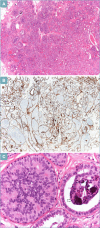Which type of cancer is detected in breast screening programs? Review of the literature with focus on the most frequent histological features
- PMID: 34042090
- PMCID: PMC8167395
- DOI: 10.32074/1591-951X-123
Which type of cancer is detected in breast screening programs? Review of the literature with focus on the most frequent histological features
Abstract
Breast cancer is the most frequent type of cancer affecting female patients. The introduction of breast cancer screening programs led to a substantial reduction of mortality from breast cancer. Nevertheless, doubts are being raised on the real efficacy of breast screening programs. The aim of the present paper is to review the main pathological type of cancers detected in breast cancer screening programs. Specifically, attention will be given to: in situ carcinoma, invasive carcinoma histotypes and interval cancer.
Keywords: breast cancer; in situ carcinoma; interval cancer; invasive carcinoma; screening program.
Copyright © 2021 Società Italiana di Anatomia Patologica e Citopatologia Diagnostica, Divisione Italiana della International Academy of Pathology.
Conflict of interest statement
The Authors declare no conflict of interest.
Figures







References
-
- Ferlay J, Shin HR, Bray F, et al. . Estimates of worldwide burden of cancer in 2008: GLO-BOCAN 2008. Int J Cancer 2010;127:2893-917. https://doi.org/10.1002/ijc.25516. 10.1002/ijc.25516 PubMed PMID: . - DOI - PubMed
-
- Bleyer A, Welch HG. Effect of three decades of screening mammography on breast-cancer in-cidence. N Engl J Med 2012;367:1998-2005. https://doi.org/10.1056/NEJMoa1206809. 10.1056/NEJMoa1206809 PubMed PMID: . - DOI - PubMed
-
- Allison K, Brogi E, Ellis IO, et al. . WHO Classification of Breast Tumours. 5th ed. Lyon: IARC Press; 2019.
-
- Park TS, Hwang ES. Current trends in the management of ductal carcinoma in situ. Oncol-ogy (Williston Park) 2016;30:823-31. PMID: . - PubMed
-
- Sidiropoulou Z, Vasconcelos AP, Couceiro C, et al. . Prevalence of silent breast cancer in autopsy specimens, as studied by the disease being held by image-guided biopsies: the pilot study and literature review. Mol Clin Oncol 2017;7:193-199. https://doi.org/10.3892/mco.2017.1299. 10.3892/mco.2017.1299 Epub 2017 Jun 21. PubMed PMID: ; PubMed Central PMCID: . - DOI - PMC - PubMed
Publication types
MeSH terms
LinkOut - more resources
Full Text Sources
Other Literature Sources
Medical

